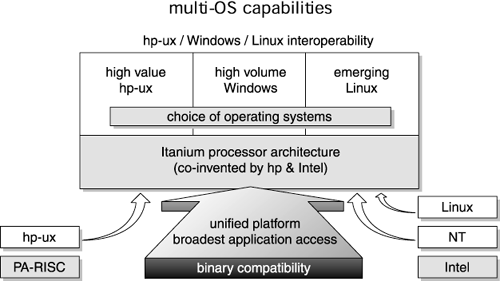Computing as a Utility
The three-tiered system is certainly one that works, but it is still centered on what kind of hardware investment an organization can make. This is why a great deal of thought during the Intel Itanium architecture development process went into how we wanted to shape computing for the decade after the millennium. The idea that came out of the lab is for a much different kind of computing capability than exists today.
The umbrella concept is to shift the idea of computing as a hardware purchase to one as a service purchase. Several original principles underlay the use of Itanium power to shift computing into this new paradigm—the paradigm of computing as a utility. Each principle was incorporated into the design capabilities of the Intel Itanium processor family.
Transparency to the End User
Transparency in this case means that the processes, the software and hardware used in the computing process, are effectively invisible to the end user. To continue in the vein of likening computing power to electricity, it is much like flipping on a light switch. Does the average person have to know how many kilowatts are available or what model the plant generators are? Probably not—it is more likely that the person simply wants an end result, in this case the automatic application of the switch to give him or her the light that is desired in an intuitive and easy manner.
Ubiquitous Presence
The new computing model would also have to be pervasive, both in constant availability and in scope. It was decided early on at Hewlett-Packard that if we were going to pursue the development of this paradigm, we wanted to do it on a big scale to make it work on a large computer that would be very fast and scalable even from an enterprise standpoint.
HP's product family spans enough categories that the pervasive nature of what we wanted is eminently doable. The product categories available span three “capacities,” including entry-level servers for departmental sharing or clustering, midrange servers for divisional or line-of-business units, and high-end enterprise servers to run the entire organization or perform heavy calculations. Each product provides leadership performance today, runs HP's version of UNIX, HPUX-11i, and offers easy upgrade features to future generations of processor technologies. The extent of the offerings at different levels is illustrated in Figure 4-2.
Figure 4-2. Extent and Types of Mid- and High-Level Computing

Intuitive Use
Given the pace of business today and the constant cycle of change in the technical world, there is a definite shift away from being concerned with how a given IT system works. Today, we're more likely to be concerned with what the system does to complete a task or project. So in many ways, people are already beginning to view computing power as an information utility or appliance.
An appliance, in computing terms, is a single-purpose system, usually stripped to the bare functionality necessary for it to accomplish its specific task. Appliances are widely used today for the “edge of network” servers. These are servers on which the user simply needs to encrypt or de-encrypt secure transactions that serve up Web pages to thousands of online users.
Ability to Handle Mixed Networks
A final principle for the computing utility concept was the ability to handle a mixed network—to work with many of the operating systems that you can find in the corporate or scientific world, as seen in Figure 4-3.
Figure 4-3. Different Operating Systems

